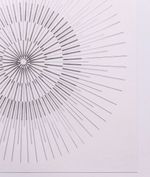Here's what you can expect during this relaxing, light-touch therapy.
To the uninitiated, reiki (pronounced ray-kee) sounds, well, a little out there. The idea that a practitioner can "harness universal life energy" through light touch might sound intriguing — yet impossible.
Even though reiki is not backed by a wealth of scientific research, it may — like other holistic treatments — offer both peace of mind and the kind of personalized care that traditional medicine sometimes fails to provide. Here's everything you need to know about the therapy.
Intro to Reiki
Reiki, which loosely translates to "spiritually guided life force energy," isn't as ancient a practice as you may think: The reiki modality in use today was developed by Dr. Mikao Usui, a Japanese Buddhist, in the early 20th century, explains Valerie Oula, Director of Vibrational Energy Healing at THE WELL and author of A Little Bit of Reiki.
During a reiki treatment (which usually lasts an hour to 90 minutes), a practitioner uses a therapeutic touch or near-touch on or just above the body to deliver both mental and physical healing effects.
First, the practitioner will ask you about your needs and intentions and tune into your energy with a brief chat. Then, you’ll lie on a massage table fully clothed while the practitioner gently places or hovers their hands on specific parts of your body. Through this method, the reiki practitioner becomes a clear conduit for the recipient’s body to draw the life force energy it needs to come into balance, Oula explains.
"The reiki practitioner becomes a clear conduit for the recipient’s body to draw the life force energy it needs to come into balance."
What to Expect
Ultimately, the experience is different for everyone. Some people feel nothing; others fall into a light sleep; some see colors; and some may feel warmth, buzzing or vibrations, explains Liza Kindred, meditation teacher and author of Eff This! Meditation.
Often, the experience shifts over the course of a treatment or changes from one session to the next. Similar to a massage, many people also feel emotional and physical releases as they sink into deep relaxation. After the session, you might find you treat yourself more gently, a benefit which can last a long time, Kindred notes.
Many reiki practitioners also incorporate crystals, sound healing or soothing essential oils such as lavender. They allow you to pursue what feels most interesting to you with the help of reiki energy, says Kindred.
As a complementary modality, reiki plays well with other holistic therapies such as natural and herbal remedies, Ayurveda, acupuncture and yoga, says Yessica Sierra-Zamora, an intuitive healer and reiki master and practitioner at Lady Lotus Energy Healing.
In addition, many reiki practitioners recommend cultivating meditation as a practice on its own and during reiki sessions. As you meditate, you may become more aware of how energy and patterns shift in your life from session to session, says Oula. In turn, this may lead to a sense of inner calm and clarity.

What the Science Says
From a scientific perspective, reiki falls under the category of “biofield therapy,” during which practitioners work with the receiver’s subtle energetic field surrounding the body to stimulate a healing response, explains Kindred. Unfortunately, researchers have yet to figure out how to measure this subtle energy or to provide enough rigorous studies to definitively show how it would be most helpful.
Still, science has discovered some benefits. According to one study, the practice might help you feel more peaceful, centered, self-confident, and cared for. Other research has pointed to benefits of reiki for those dealing with illness or pain, showing that reiki sessions helped improve relaxation, pain relief, sleep quality and reduced anxiety in hospital patients.
"Studies show reiki may help significantly reduce pain, blood pressure and anxiety."
Still further studies show reiki may help significantly reduce pain, blood pressure and anxiety, so much so that a recent review determined its positive effects span beyond the placebo effect. Researchers believe benefits could be attributed to the activation of the parasympathetic nervous system (and the coinciding slow down of breathing, heart rate and blood pressure). “Reiki energy is not an exciting or frantic energy — it is gentle and curative,” says Kindred.
However, it's important to note that other scientific reviews find insufficient evidence to back up some of the health claims of reiki. And of course: “No responsible reiki practitioner would suggest that it can replace medical care, but its healing energy can be a wonderful complement,” says Kindred. In fact, reiki is now offered in some hospitals in the United States alongside conventional treatments.
Who Is Reiki Right For?
Anyone and everyone, from babies to pregnant women to those in hospice care, could benefit from reiki, says Oula. In particular, if you’re dealing with a chronic health condition such as fibromyalgia, anxiety or depression, a reiki session might help reduce symptoms like pain and distress, especially if you’re too sensitive for a typical massage, says Sierra-Zamora. Many children with autism, ADD and ADHD also enjoy the benefits of this modality, she adds.
You can opt for regular ongoing reiki treatments or use a handful of sessions to get through a difficult time and restore balance in your life. “I find reiki particularly useful for those times when everything just feels off; as we restore balance to our own energetic systems, we can begin to tap back into that feeling of wellness and of alignment with the world around us,” says Kindred.
“One of the beautiful things about reiki is that the energy flows where it is needed,” notes Kindred. Whether you’re feeling stressed out or have an ache in your back, an hour of light, focused touch may help you relax, release tension and simply feel better. “It can do its work whether or not you’re open to it — although it can be a lot more powerful if you are.”
It can do its work whether or not you’re open to it — although it can be a lot more powerful if you are.




